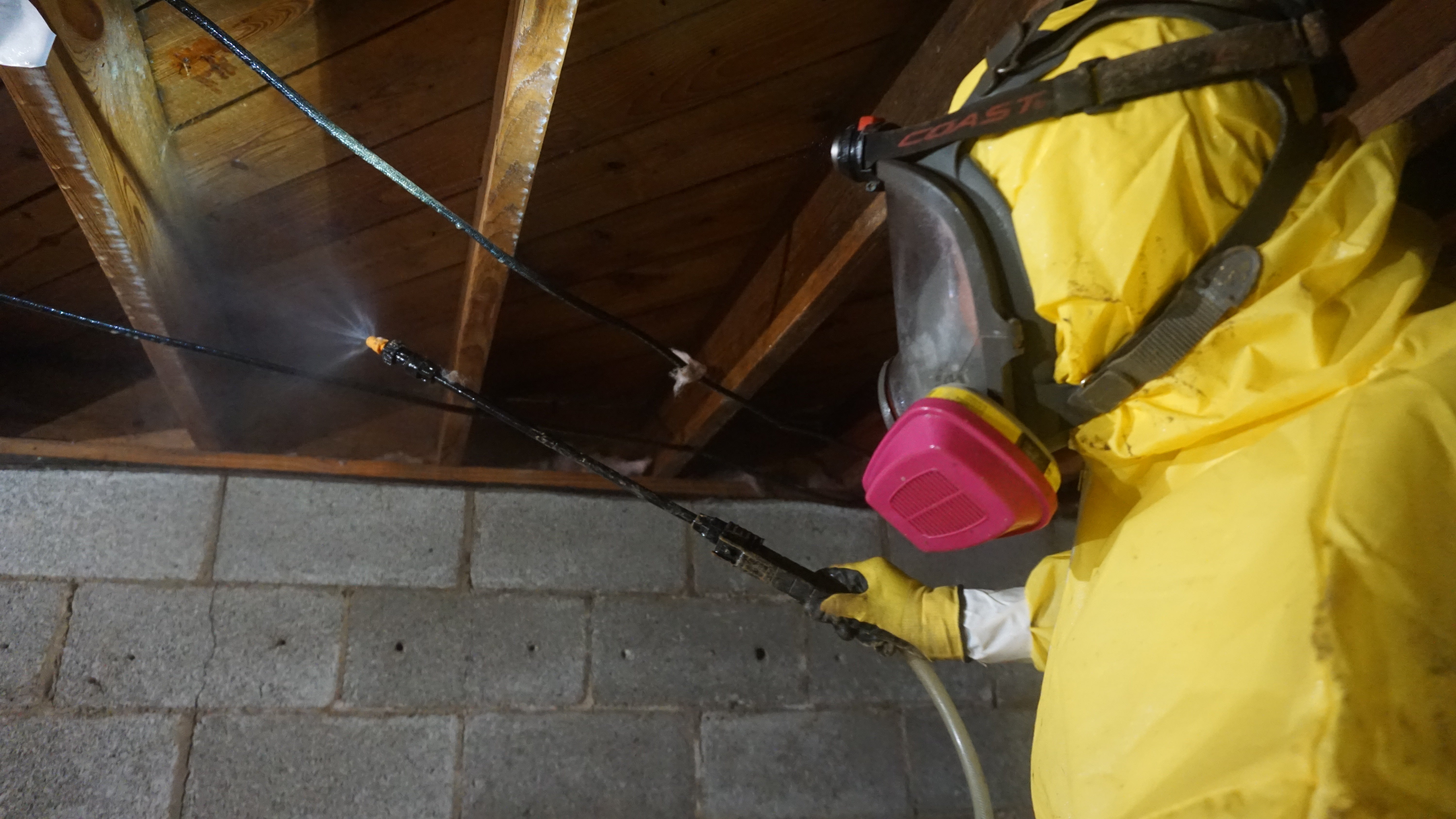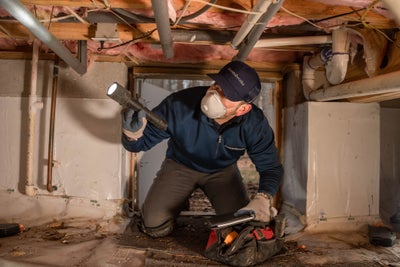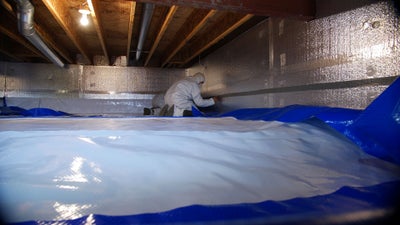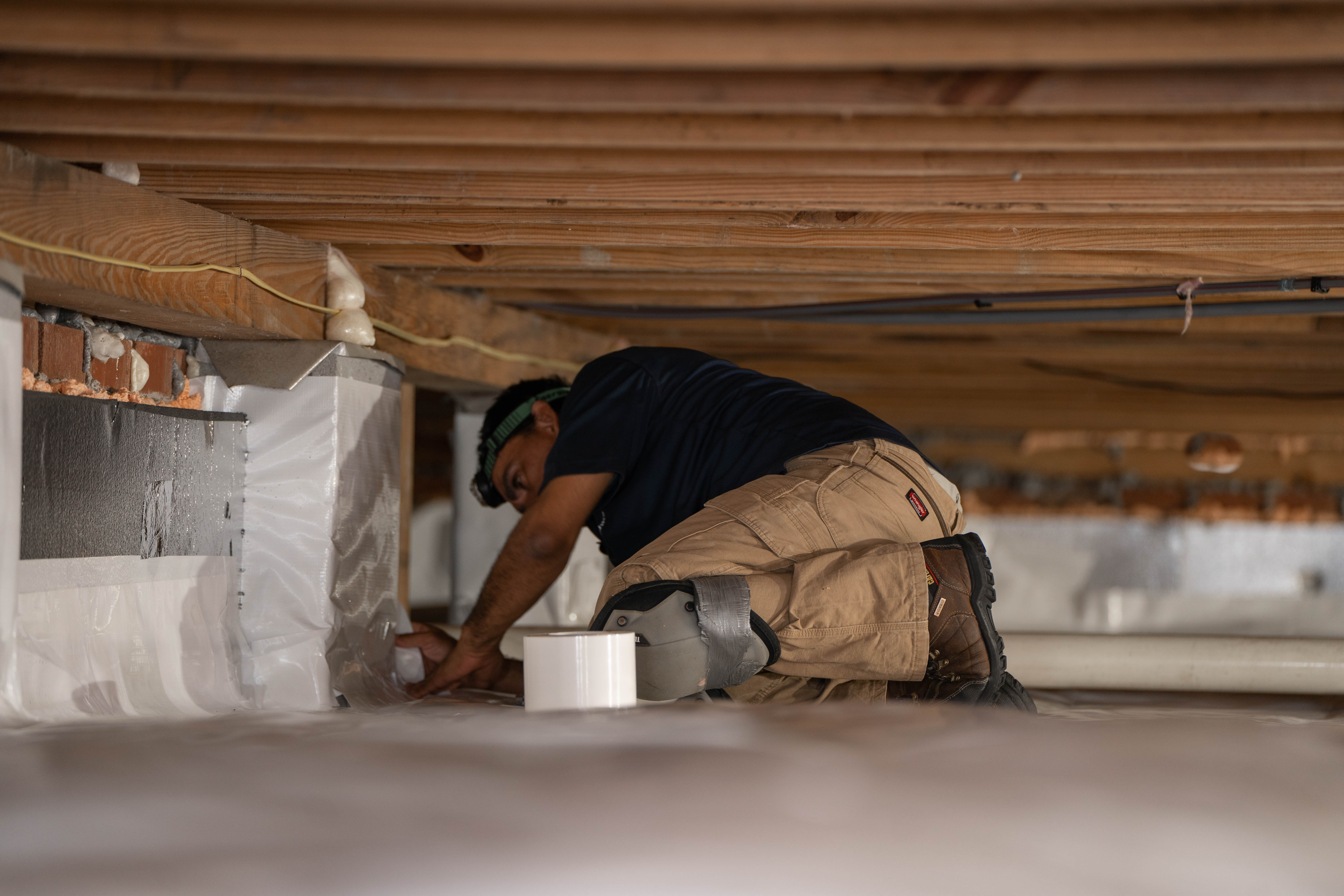8 Steps to Install Vapor Barrier & Seal Out Moisture
Crawl spaces are damp, dusty, and all around dirty, so it’s no surprise if you haven’t been down there much. But what if that wasn’t the case? What if you could create a clean, dry, usable crawl space?
Well, you can with a crawl space vapor barrier. Thanks to modern innovation, vapor barriers are some of the most effective crawl space waterproofing tools on the market. In this article, we’ll explore why installing vapor barriers is beneficial, and how to install one beneath your home.
Why Is Installing a Vapor Barrier Important?

About 15 percent of homes built since 2013 have a crawl space foundation, and if that incudes yours, you need to understand what can happen without a vapor barrier.
Moisture poses a huge threat to your home. When water (or water vapor) gets below your home, it is absorbed by the wooden structural supports found in most crawl spaces.
Over time, this leads to problems like mold, wood rot, or sagging floors. A wet, damp crawl space is also an ideal breeding ground for insects and rodents.
Sealing your crawl space with a vapor barrier is a great way to keep your crawl space healthy. Doing so can ensure that your family is breathing clean, conditioned air, and wooden support beams below your home stay safe.
Keep in mind, a vapor barrier alone is not enough. While it’s one of the best first steps to take it works best as part of a crawl space encapsulation system. For the most efficient protection, we recommend installing a dehumidifier, crawl space drains, and insulation alongside your vapor barrier.
How Does a Vapor Barrier Work?
In short, vapor barriers cover the walls and floors of your crawl space to seal out moisture. According to the U.S. Department of Energy, controlling the moisture in your home can make your home more energy-efficient and less costly to heat and cool.
Without a doubt, installing one prevents water vapor and ground moisture from entering the crawl space and causing problems. Remember that a crawl space vapor barrier can only offer its full benefits if it is airtight—air from outside must not be able to sneak in through walls, vents, or the floor.
This is where encapsulation from a trusted, professional foundation company like Groundworks comes in.
Is Mold Removal Necessary First?

One of the common crawl space red flags is mold. Mold is often the first indication of a problem. So, is it important to remove the mold before installing a vapor barrier?
Of course, the answer depends on how long the problem has been festering and how much mold is present at the time of installation. While the United States Environmental Protection Agency says if mold is less than 10 square feet (or a 3ft. by 3ft. area), you can clean the mold yourself, it’s best to err on the side of caution. Entering your crawl space and exposing yourself to mold and other problems can be dangerous, so it’s best to contact a mold remediation specialist for safe and effective removal.
Mold needs three things to survive: water, food, and oxygen. Without these three elements, mold will cease to exist. Since oxygen and food (dead organic materials) like wood, aren’t going anywhere inside your crawl space, removing water is the easiest way to prevent mold below your home.
In this case, installing a vapor barrier during encapsulation removes water from the equation. However, if your crawl space has a large amount of mold, it’s a good idea to have it removed by a professional before moving forward with a vapor barrier installation.
How to Install a Crawl Space Vapor Barrier Step by Step
Step 1: Diagnosis
First, before installing a vapor barrier, it’s important to do a full inspection and determine the cause of the crawl space problem. Is groundwater entering from the floor or walls? Are open vents trapping humid air inside? Is a plumbing leak dripping into the space? Ensuring the solution matches the root problem goes a long way to preventing future problems.
Your local Groundworks inspector will consider your neighborhood’s unique soil type, the typography of your home, and the weather conditions before making repair suggestions.

Step 2: Crawl Space Clean Up
Then, the crawl space needs to be cleaned.
Depending on the condition of the crawl space, this step may look different for everyone. If your crawl space is wet, it’s beneficial to dry it out with a submersible pump, fans, or a dehumidifier. Sometimes, this process may take a while. Consider mold remediation if needed.
All fallen insulation and scrap building material should be bagged and removed.
Step 3: Crawl Space Grading & Preparation
Next, the floor of the crawl space should be clear of large rocks and debris. This also includes any pests that might be inside the crawl space. Any collapsed insulation needs to be removed as well. Finally, the soil should be raked to establish a rough grade.
Step 4: Seal Crawl Space Vents
It’s crucial to close and conceal any open crawl space vents to avoid air, water, and pest intrusion. Your local Groundworks company will custom-fit blocks of insulation panels in the interior vent opening before fully encapsulating the crawl space. Exterior vent covers can be added upon your request.
Step 5: Install Waterproofing Measures
Afterward, depending on the amount of water in your crawl space, consider installing a specially designed crawl space sump pump or other drainage options to remove any water that would remain beneath the vapor barrier.
Step 6: Insulate Walls
Then, the wall insulation is attached to the interior crawl space walls with either an adhesive or a special masonry fastener.
Step 7: Installing the Vapor Barrier Liner
Now, measure and cut a high-quality vapor barrier to fit the crawl space and allow several inches to run along the walls. Be sure to overlap seams for taping using a double-sided tape.

Step 8: Condition the Air
Finally, now that your crawl space has been sealed, you need to establish a positive airflow. This can be accomplished by installing an energy-efficient dehumidifier.
Groundworks: Vapor Barrier Experts

While the solution to install a vapor barrier in your crawl space is fairly straightforward, the job can be exhausting, back-breaking work. In addition, with your crawl space being a tight, small area, it’s not uncommon to be working on your back or stomach during the duration of the work. Moreover, this doesn’t mention the numerous trips through the crawl space access point, which can be difficult.
The experts at Groundworks install vapor barriers and encapsulate crawl spaces every day. As a result, we have the best products and procedures to make installation as simple and effective as possible. Our 20-mil CrawlSeal™ liner locks out moisture and soil gases and comes with a nationally backed, long-term warranty.
If you’re noticing sagging floors or high energy bills, your crawl space problem won’t get better with time. Let Groundworks install a vapor barrier and encapsulation system to seal and eliminate your crawl space problems.
In conclusion, let us do the hard work. Call to schedule your free inspection today or book online. Schedule a time and date to have an inspector put eyes on your problem and suggest solutions that don’t involve you losing your weekend beneath your home.
FAQs
Crawl space encapsulation can enhance your home’s health and value by decreasing the risk of mold, mildew, and structural damage. However, the extent of its impact on home value varies depending on the local real estate market and potential buyer preferences.
A high-quality vapor barrier matters because it will last longer and handle more moisture effectively. Groundworks’ 20-mil vapor barrier, with its 25-year warranty, ensures your crawl space remains secure and dry for years to come.
Most building codes mandate a 6-mil crawl space vapor barrier, but this is the absolute minimum, and it isn’t very effective. Many companies offer a 12-mil crawl space vapor barrier, but even at this thickness, you can still end up with many problems. We use a 20-mil crawl space vapor barrier to make sure your crawl space stays as dry as possible.

